#aeration solution
Text
The Lifesaving Flow: Exploring the Importance of Water Movement in Biofloc Aeration
In the bustling world of fish farming, every ripple counts, and one silent hero often goes unnoticed: water movement. Particularly within the innovative world of biofloc technology, ensuring proper aeration through water movement isn't just important—it's indispensable. Let's embark on a journey to uncover the many benefits of water movement, explore the potential consequences of its absence, and zoom in on the remarkable role of bubbles in biofloc aeration.
The Important Role of Water Movement
Water movement isn't just about creating pretty patterns in a tank; it's about sustaining life within aquatic ecosystems. In biofloc systems, where microscopic communities thrive and fish rely on a delicate balance, water movement is the beating heart that keeps everything in harmony.
1. Oxygenation: Picture this: fish gasping for breath in still water. Without enough oxygen, aquatic life suffocates. Water movement ensures that oxygen-rich water circulates throughout the tank, providing a lifeline for fish, shrimp, and the tiny creatures that call biofloc systems home.
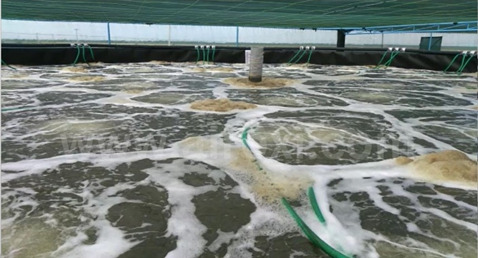
2. Nutrient Distribution: Just like plants need water to transport nutrients from roots to leaves, aquatic organisms depend on water movement to distribute essential nutrients and food particles. Without this movement, some areas of the tank become nutrient-deprived, hindering growth and productivity.
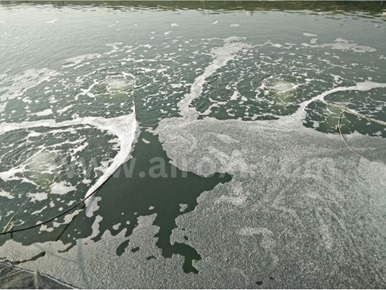
3. Temperature Regulation: Water movement plays a crucial role in maintaining optimal water temperatures. It prevents thermal stratification, where warmer water accumulates at the surface and colder water sinks to the bottom. By promoting uniform temperatures, water movement creates a comfortable environment for aquatic life.
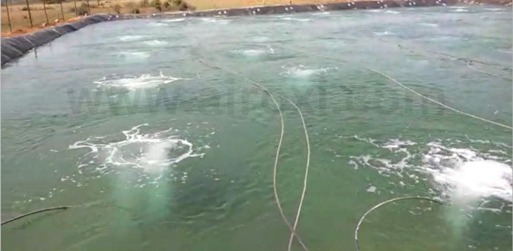
4. Waste Removal: Imagine living in a room without windows or doors—eventually, it would fill up with trash. In biofloc systems, water movement prevents waste from accumulating by carrying it away from the living areas of aquatic organisms. This reduces the risk of water pollution and maintains clean water quality.
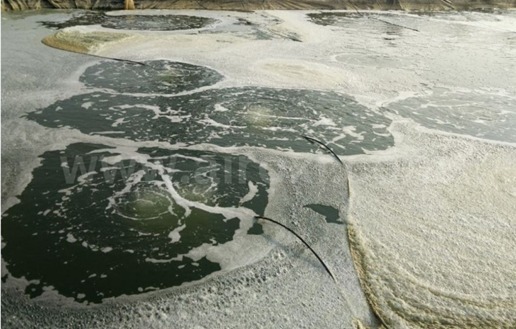
The problems caused by low water movement
Now, let's think about the bleak scenario of stagnant water within fish farming systems. Without the gentle movement of water, life within biofloc tanks would spiral into chaos.
1. Oxygen Deprivation: As oxygen levels drop, fish and other aquatic organisms struggle to breathe. Without enough oxygen, they become stressed, vulnerable to diseases, and ultimately face suffocation—a sad fate for creatures that rely on the very substance dissolved in the water around them.
2. Nutrient Imbalance: In the absence of water movement, nutrients and food particles settle at the bottom of the tank, creating localized hotspots of abundance and barren deserts elsewhere. This imbalance disrupts the delicate ecosystem dynamics, leading to stunted growth, malnutrition, and increased competition among organisms.
3. Temperature Extremes: Still water becomes a breeding ground for temperature extremes. Without the moderating influence of water movement, surface waters may become excessively warm, while deeper waters remain frigid—a recipe for thermal shock and stress among aquatic inhabitants.
4. Toxic Buildup: Waste products, such as ammonia and carbon dioxide, accumulate in still water, poisoning aquatic life. Ammonia, released as a byproduct of organic decay and excretion, reaches toxic levels, impairing fish health and compromising immune systems. Meanwhile, carbon dioxide accumulates, lowering pH levels and further exacerbating the toxic environment.
The Marvel of Bubbles: Aeration in Biofloc Systems
Now, let's zoom in on a fascinating aspect of water movement in biofloc systems: the role of bubbles. Bubbles aren't just whimsical spheres dancing in the water; they're tiny messengers of life-saving oxygen. AirOxi diffusers and aeration tubes are some of the examples of this kind of aeration which also provides water movement. You can find out more information here www.airoxi.com and buy the airoxi tubes here www.buy.airoxi.com
1. Oxygen Infusion: Bubbles act as carriers of oxygen, ferrying precious air from the surface to the depths of the tank. As they rise through the water column, bubbles release oxygen molecules, enriching the surrounding water and sustaining aerobic microbial activity.
2. Mixing Magic: As bubbles ascend, they create a whirlwind of motion, stirring the water and promoting mixing. This turbulent action prevents stratification, ensuring that oxygenated water reaches every corner of the tank and revitalizes the entire ecosystem.
3. Surface Splash: When bubbles burst at the water's surface, they create a splash that enhances gas exchange. This process facilitates the removal of carbon dioxide—a metabolic waste product—and replenishes oxygen levels, rejuvenating the aquatic environment.
4. Aesthetic Appeal: Beyond their functional benefits, bubbles add a touch of whimsy to biofloc systems. Watching bubbles dance through the water can be mesmerizing, fostering a sense of connection with the aquatic world and inspiring awe in observers.
Expanding Horizons: Harnessing the Power of Bubbles
In the journey for optimal water movement and aeration, harnessing the power of bubbles becomes paramount. Here's how we can maximize the effectiveness of bubbles in biofloc systems:
1. Bubble Dynamics: By optimizing bubble size, distribution, and release rate, fish farmers can fine-tune aeration levels to meet the specific needs of their biofloc systems. Smaller bubbles offer greater surface area for oxygen transfer, while controlled release ensures efficient oxygenation without causing turbulence-induced stress to aquatic organisms. Ensure that the AirOxi tube that you select for aeration is of proper size and is as per the blower that you have decided. To see which blower is suitable for your aquaculture you can read our previous blog here www.airoxi.com (which blower is suitable)
2. Aeration Devices: Investing in high-quality aeration devices, such as fine-pore diffusers or air stones, enhances bubble performance and longevity. These devices create a fine mist of bubbles that linger in the water, gradually releasing oxygen and promoting sustained aeration.
3. Strategic Placement: Positioning aeration devices strategically throughout the tank ensures uniform oxygen distribution and prevents dead zones where water movement is limited. By targeting areas prone to stagnation, such as corners or beneath dense biofloc mats, fish farmers can mitigate the risk of oxygen depletion and promote optimal conditions for microbial growth and nutrient recycling.
4. Monitoring and Adjustment: Regular monitoring of water quality parameters, including dissolved oxygen levels, allows fish farmers to assess the effectiveness of aeration strategies and make timely adjustments as needed. By maintaining a delicate balance between aeration and water movement, they can optimize the health and productivity of their biofloc systems.
Conclusion: Riding the Wave of Biofloc
In the ever-changing world of fish farming, the importance of water movement in biofloc aeration shines brightly as a beacon of innovation and sustainability. From the life-sustaining benefits of oxygenation and nutrient distribution to the mesmerizing dance of bubbles, water movement holds the key to unlocking the full potential of biofloc systems. By embracing the marvels of modern technology and harnessing the power of nature, fish farmers can ride the wave of innovation toward a future where thriving aquatic ecosystems coexist harmoniously with sustainable fish farming practices.
As we navigate the challenges and opportunities of aquaculture, let's remember the crucial role of water movement—a lifeline for aquatic life and a cornerstone of sustainable fish farming. By understanding and harnessing its power, we can pave the way for a brighter, more resilient future for our oceans and the communities that depend on them. Together, let's continue to explore, innovate, and protect the precious resources that sustain life beneath the waves.
Contact AirOxi for your aquaculture aeration requirements
+917041004098
www.buy.airoxi.com
0 notes
Text
Enhance Your Construction Projects with ONE AAC PANEL - Your Premier Source for Top-Quality Aerated Concrete Solutions!
Unlock the power of Aerated Concrete with ONE AAC PANEL, the leading provider of AAC solutions. From AAC panel walls to blocks and flooring systems, we offer a comprehensive range of products designed to meet your construction needs. Our autoclaved aerated concrete (AAC) boasts exceptional thermal insulation, durability, and sustainability, making it a smart choice for residential, commercial, and industrial projects. Discover the unmatched benefits of AAC and take your construction projects to new heights of quality and efficiency. Experience the ONE AAC PANEL difference today and build with confidence. Your success starts here!

1 note
·
View note
Text
Alrighty so this is the post on lichen dyes!
this particular bath of lichen dyes was originally started over a year ago scraping a tentatively-ID'd lecanora and/or ochrolechia genus lichen off of a fallen branch (remember, don't gather lichen when it's still growing! it's very slow growing and easy to overharvest)
to start off, this particular type of dye is made through the ammonia-fermentation method, also known as ammonia maceration. No actual bacterial fermentation occurs though. Rather, the compound orcinol (and precursor compound to orcinols) react with ammonia (N2) and oxygen to form the compound orcein (also called orchil/archil) which is what makes the final dye!
this process takes anywhere from 3 weeks to 16+ weeks depending on the lichen species, its constituent acids, the temperature, and the frequency of aeration.
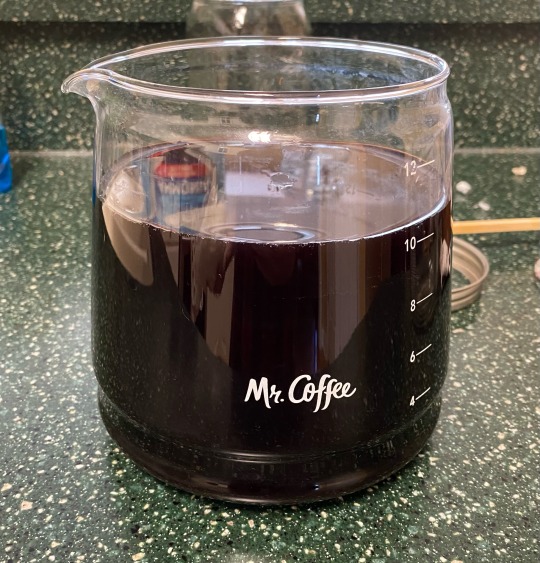
This batch was set aside for several months and neglected a good bit, but it still works. I strained out the crumbled lichens (which i set aside for later) and diluted it 1:4 as instructed by a very good book called Lichen Dyes: The New Source Book by Karen Diadick Casselman. This book is basically omnipresent everywhere you see lichen dyes mentioned, especially the orcein-based dyes. I also used several websites/videos/papers and such that i've hunted down over various internet crawls.
I use an old coffee pot for this as it's both a non-reactive material (glass) and is built to withstand heat. Ironically i also scraped the lichens off the branch using a tool i made out of a metal band from the broken handle of this same coffee pot!

I decided to dye some eri silk cakes that i fluffed up and scoured. these have been very good at absorbing dye in the past so i would hopefully get a good result from them. As lichens are a substantive dye i don't have to put a mordant on them, but i did soak them in an alum solution just before adding them to the dye bath to hopefully maximize dye uptake as well as improve fastness as lichen dyes are also fugitive and can fade in sunlight.
Substantive dyes contain mordants already embedded in them; fugitive dyes are a bit fuzzy to me but my understanding is they end up trapped in the fiber instead of actually bonding to the fiber in a stronger way. Mordants are used to help the dye "bite" onto the fiber better, improving both fastness (the ability of a due to resist fading from sunlight/washing/time) and the brightness of a color. Alum is useful in that it typically doesn't affect the end color of a dye more than simply making it slightly more strong!
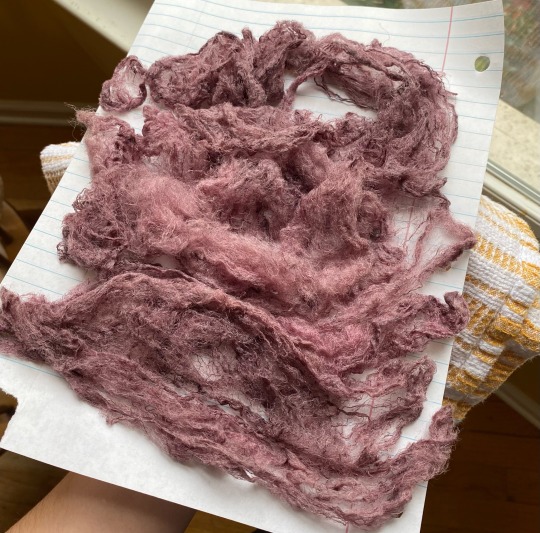
it was pretty successful i'd say! i warmed up the dyebath, added the silk, let it simmer for a few hours, let it cool down overnight, and then warmed it back up the next day for a few hours; then, when it cooled, i took it out, let it dry, then rinsed it, and let it dry a second time. At that point, it was ready for spinning!
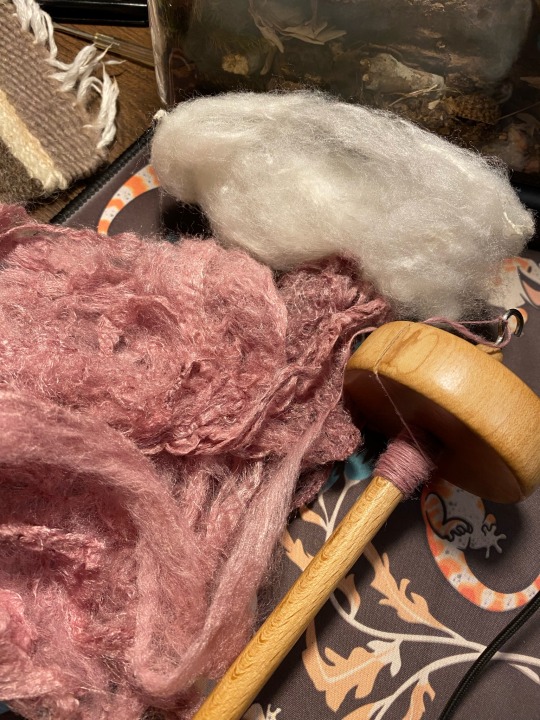
It was a lovely pink color that's not fully captured by the camera like most dyes, and eri silk is lovely because you can spin the clouds directly and easily without carding and make lovely relatively threadlike yarn

this was the first skein i got! i love how shiny the silk is. Some dyes can get really purple or even magenta-like!
next, i had the leftover lichens that i had set aside. They were a crumbly texture and dark black and i dried them out, crushed them up more, set them back in a jar, added more ammonia and water, and did the ammonia fermentation method a second time! this was after reading about the method for making french purple, and while this is definitely a very pale imitation of the method, the double-soak is the key feature here
here it is (on the left); it was already way darker purple than an in-progress lichen dye i had yet to crack open and use

speaking of which, heres a shot of various test lichens i had while working on this, you can see the blue-capped jar that has the second-soaked lichens. the foam will often give a preview of whether or not the dye will be red/purple or not!

Here it is, i forget how long i let it soak but i think it was a bit over a week. i strained the material out, diluted it, and then repeated the same warm/cool/warm/cool/dry/rinse/dry method with more eri silk

And below you can see the difference, it's definitely slight but still cool!

the left is from the original dyebath, the right is the second-soaked one. the first one is more salmon-colored while the second is a tad more blue-purpled!
I'm extremely excited about this, these dyes have such a fascinating history and have multiple historical uses everywhere from florentine orchil to norwegian korkje to scottish cudbear and more, and it was often used in tandem with the roman murex/tyrian purple dyes that come from a mussel. Some folks used the lichens to pre-dye the fabric before dyeing with tyrian purple, both to stretch the expensive tyrian purple and to make the end color more vibrant. It's all such a great topic that's mightily confusing and could take up a post of its own, same with the underlying chemistry of what makes these dyes work in the first place!
Anyways that's all for this post, i have more i'm working on involving actually turning these dyes into paint that i'll hopefully turn into a post on its own soon! I've also got other lichen dyes I'm waiting to get through the ammonia fermentation process that will hopefully give other colors, whenever that may be!
#lichen dyes#ammonia fermentaion#handspinning#natural dyes#eri silk#yarnmaking#fiber arts#vegetable dyes#orcinol#art#orcein#archil#crafts#yarn#silk#drop spindle
607 notes
·
View notes
Text
The Lab Rats
Dave the Human and Dave The Human were checking on the moss substrates - Spot checking for anything that might have snuck in, or any environmental issues that could be detected by checking the moss's bio-accumulation.
Garfield "Garf" Bloom, a 7ft tall, kinda reptilian biped rolled in, in her normal-for-the-species gait, hauled out Un-Named Male, her little guy, out of her pouch and dropped him from a moderate height onto the moss bank.
"Hey Garf." said the Dave that was a female Tsin for biological reasons and a male human for Payroll reasons.
"Yo, you two." said the Dave who was Human, plausibly male but had spent a week as a Female Atrix, as part of a plot to annoy the government.
Un-Named Male flashed a howdy with his display patch and wiggled into the patch of purple moss happily, which is a small Atrix's natural habitat.
"So I heard that the Human science labs still use rats." Garf said. "Do you... not use bio-chips or clone cells?"
Dave with scales scratched her chin. "Dave, you want to take this one?"
Other Dave wiggled a probe into a particularly scruffy clump of moss and nodded. "Indeed I do!" he said.
"You see, rats are very social, and have a short generation span. Back before we could load up cells onto a chip for testing we needed them for... well testing."
"Yesh! Pretty much everyone did that at some point in history." added Dave The Human, Running a spectrograph on a sample to check the light absorption was within the expected range.
Un-Named Male jsut lurked in the soft, moist moss and let the high UV lighting play on his back, which added nothing to the conversation, but he did look very comfortable.
"Right. So when it stopped being necessary for uh, biological testing, rats were often used for behavioural testing. Non-human cognition, social studies, that sort of thing."
"OK..." said Garf, quietly wiggling her fingers into the moss and making a kneading motion, a common and casual motion that would break up the substrate and allow aeration. It was soothing - Even a big Atrix like Garf remembered the comfort of hiding in a moss patch.
The Atrix parts of The Station were basically covered in various species of Moss - Their solution to air quality and comfort, and it'd taken the humans about nine seconds to point at a wall mat of deliciously verdant and fuzzy plant life and go 'Want!'.
Indeed, the introduction of non-native species for one's living quarters was just one of the benefits of the Human-Atrix alliance.
The Tsin, who developed scales to keep their water on the inside had not really taken to it so much, but if you want some fungus to add a little pizazz, they're the go-to.
"Anyway, eventually it sort of got to be a hobby thing. People like rats. They make great pets, they quite like us, and they're very non-judgemental. So someone did this study and found that labs that had a colony of two or more rats had better results... The scientists could go over and fuss with the little fuzzballs and de-stress, and it turns out if you sit down and explain your experiments to a rat, you often figure out what is causing you problems."
"Seriously?" asked Dave The Human.
"Seconded." said Garf.
"Wait, aren't they vermin?"
"Oh totally." said Dave, "Well some are. Same species. But... it turns out if you give them the opportunity they're little fuzzy buddies, so we brought them with us."
"And they're used by human scientists... to figure things out indirectly?"
"For real. Sometimes they get cited in papers as authors," said Dave happily. "I used to keep a couple when I was a Little Guy"
Note: Little Guy in this case is an Atrix phrase.
The Atrix pretty much only have one gender which is size. It actually doesn't distinguish male or female. That's a human thing. Even the Tsin have four biological sexes.
Un-Named Male is only nominally male because he's small. He is an adult of the species. One day he's going to put on some body mass and develop bipedal locomotion and eventually be a large Atrix, and get his own Little Guy, and be referred to as female.
"That's why they're called Lab Rats - They're essential to Human Science."
Garf pondered this, leaning to run her cheek along a mossy wall. "We just talk to our little guys." she noted casually and a patch of moss said "Grak" in confirmation.
The Tsin in the room made a face. "Dang, yo. I think we're missing out!"
"Hmm," said the more human of the Daves. "I smell an Interspecies Xenthropology collab..."
And that, dearly beloved, is how the Tsin got their Rats.
#rats#station stories#dave the human#atrix#tsin#humans being weird little guys#humans are weird#haso#humans are space orcs
131 notes
·
View notes
Text
Closing Loops in Soilless Gardening - Hydroponics and Aquaponics
What is the future of food production going to look like? Is the projected 10 billion people in 25 years, out of which two thirds will live in cities, going to require us to convert every square meter of arable land into intensive mono cultural farms? Please don't let that be true! There HAS to be some alternative. Fortunately, there are several. Two of them are different ways of growing plants without soil, a radically new method, which may be most appealing to urban food production.

image source
Hydroponics: Growing Plants in Water
When it comes to growing large amounts of food on a small area efficiently, hydroponic systems are often brought up as a solution. And the reasons sound pretty convincing: An efficient hydroponic farm uses 90% less water, and can yield 3-10 times the amount of produce per area, with 7-14 growth cycles in a year. IMPRESSIVE! But before getting too excited, let's not forget: the devil is in the details! It's worth looking into under exactly what conditions those plants grow, being fed by what light, and most importantly which nutrients, and where they come from.
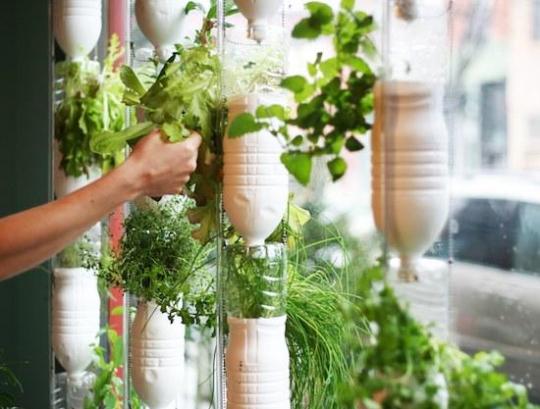
image source
The basic concept, however, of growing plants vertically, in mostly water, with some kind of substrate, such as clay balls or vermiculite, is actually a pretty nifty way to grow food where there are no fields. The most basic form of this may be the Windowfarm technique, which I experimented with myself years ago in my Budapest apartment. Going to Shanghai, the whole idea seems to be taken to a whole new level.
https://static.dezeen.com/uploads/2017/04/sunqiao-urban-agricultural-district-Sasaki-architecture-industrial-china-shanghai_dezeen_hero-b.jpg
image source
Is That Really Sustainable? Or Even Healthy?
… not to mention, does hydroponics even fit into Permaculture? Because let's be honest: with a system that needs to be constantly managed and monitored you could not be further from a self-supporting ecosystem. Also, what exactly do those plants get to eat? The typical N-P-K made industrially out of petrochemicals? Most likely. So while it certainly reduces the transport related drawbacks, hydroponics is by no means energy efficient, and the nutritional value won't be any better than your most industrially grown veggies.

image source
How Does Aquaponics Compare?
Okay, so let's bring in the fish! For those not familiar with the difference between the two systems, aquaponics is the combination of hydroponics and aquaculture, which are simply fish farms. Having fish in a tank, they will naturally defecate into the water, requiring it to be changed regularly. Plants, however love to eat those nutrients that the fish excrete. Or to be more exact, they feed on the nutrients that have been converted by bacteria and other microbes. The ammonia will turn in to nitrites, which in turn become nitrates, that is food for the plants.
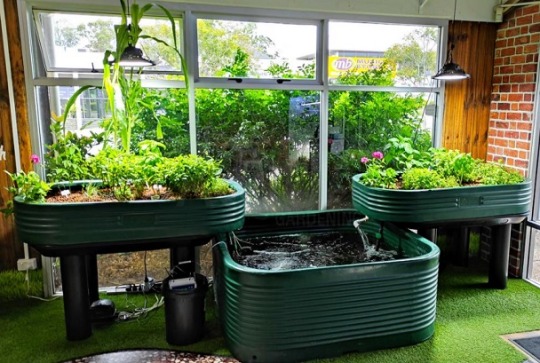
image source
So running the water from the fish through the plants growing substrate will on one hand feed the plants, as well as clean it for the fish to enjoy it again. So the system already closed a few loops there, making it more sustainable than just mere hydroponics. Also, the inclusion of microbes already offers a more diverse environment, bringing the system a bit closer to an ecosystem. But let's not get ahead of ourselves: Aquaponic systems still need close monitoring, as they are still a far cry from a self sustaining ecosystem of let's say a pond. Also, the water circulation / aeration is most likely going to require a pump, and depending on the exact setup of the system, maybe artificial lighting for the plants. All these aspects add to the energy requirement of the aquaponic system.
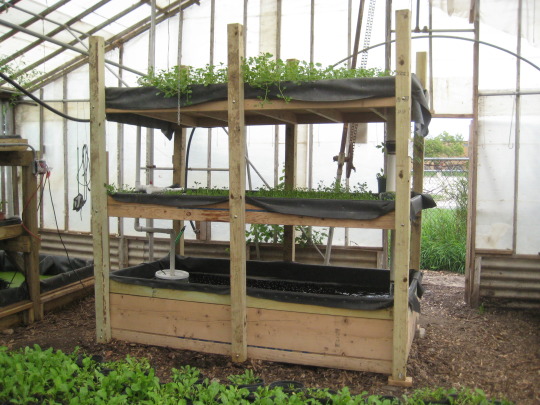
image source
A Truly Closed Loop? Consider the Food of the Fish!
When praising the sustainability of aquaponics, one thing that mustn't be ignored is the source of the fish food. Just like with the hydroponic systems, where the food for the plants or the fertilizer is considered, we can't ignore the feed we give to our fish to eat. If it is the same industrial feed, we may as well have kept to our hydroponics. Not true, since including fish already makes our system more diverse. So instead, let's continue in that same direction. What do fish eat? What is good for them? How can we grow that food ourselves?

image source
Making Your Own Sustainable Fish Food
Here I could probably start a number of individual posts, since talking about fish food is like opening up a can of worms. But fortunately, I already have a number of appropriate things written. Talking about worms, by the way, anyone who has been fishing knows that they are a favored delicacy, and anyone who composts will have no shortage of them. Since worms are mostly vegetarians, and many of us eat meat, it may have been a bit difficult to properly compost greasy, meaty, bony food wastes. That's where black soldier flies come in, whose larvae are also frequently mentioned for fish food. I still need to try growing those guys. As for green plants for the fish, duckweed makes also good fish feed, again something I have no experience with. What I do know, though, is spirulina, which is also super rich in nutrients, and I would be surprised if the fish didn't like it. So I can see throwing some composting worms, black soldier fly larvae, and spirulina into a blender, to make some great nutritious fish food. At the moment this is very theoretical for me, though.

image source
Don't Give Up the Soil Completely
So does this mean we should all focus on setting up our most sustainable fish-plant-compost combo cycles? Hells yeah! But please not at the expense of everything else! Soilless gardening, as exciting and revolutionary as it may sound, is still that: without soil. And let's face it: neither us, nor our beans and tomatoes, have evolved to live entirely without soil. That just seems wrong. Even in a small urban apartment it's worth having a bit of soil on your roof, balcony, or window sill, where you can dig your hands into a world of healthy microbial diversity on occasion. And if you do have the space, by all means, set up a pond, a dam, or another aquatic ecosystem, where fish, and frogs, and dragonflies, and numerous other species can live together without relying on our management. Apart from looking pretty, they will also provide food for us, that is nutritionally superior to anything industrially grown.
Sources: 1, 2, 3, 4, 5, 6, 7, 8
115 notes
·
View notes
Text
Chastity
The chastity cage, a standard issue for recruits, boasted a design that seamlessly integrated with the advanced technology of the Armour Suits.

Material: Nano Plastics and Ceramics
Dual-Chamber Design: Separation for Testicles and Penis
Locking Mechanism: Secure yet easily accessible for hygiene and maintenance
Anti-Tamper Sensors: Alerts the AI in case of unauthorized attempts to manipulate the device
Temperature Control: Maintains a comfortable temperature within the chambers
Aeration System: Allows for ventilation to prevent moisture and ensure skin health
Customizable Restraint Levels: Adjustable settings for varying degrees of security
Medical-Grade Monitoring: Monitors physiological health and provides feedback to the wearer
Compatibility: Integrates seamlessly with Armour Suit technology and HUD interfaces
Hygienic Seals: Ensures cleanliness and reduces the risk of infection
Comfort Padding: Medical-grade silicone for extended wear
Adjustable Fit: Customizable sizing to accommodate individual anatomical variations
Durability: Resistant to corrosion, impact, and extreme environmental conditions
Charging: Wireless induction charging for convenience
Compliance: Meets Tactical Paramedic Corps regulations for personal equipment
This state-of-the-art chastity cage goes beyond mere physical restraint, incorporating advanced technologies to ensure both security and the well-being of the wearer. Its dual-chamber design, combined with biometric authentication and anti-tamper features, establishes a new standard for personal discipline within the Tactical Paramedic Corps.
Shielded from external access, both the penis and testicles find residence in specially designed chambers crafted from premium silicone rubber. The surface texture mimics natural skin, ensuring a comfortable fit without leaving any discernible pressure marks. Within this chamber, a clear division accommodates the separate housing of the penis and testicles. The penis tube takes on a downward-bent configuration for optimal comfort.
Dedicated protection is afforded to the testicles through an independent chamber, shielding against pinching and providing a cooling effect. The larger size, complemented by a more spacious tube, enhances overall comfort. Additionally, ample room for expansion is available to prevent any sense of constraint in case of enlargement.
When nature calls, there's no requirement to unlock the belt. The penis tube seamlessly connects to an opening at the bottom of the belt. To prevent any potential blockage caused by an erect penis, a reservoir ensures the discharge point remains unobstructed.
The chastity belt integrates seamlessly with the armor suit's docking system through a specialized interface mechanism. The belt is equipped with a proprietary docking port that aligns precisely with the corresponding receptacle on the armor suit. This connection is established using a secure locking mechanism that ensures a robust and tamper-proof link.
This connection not only facilitates power transfer and data exchange but also ensures the proper functioning of integrated systems.
Upon docking, a series of verification protocols are initiated, confirming the integrity of the connection and the operational status of both the chastity belt and the armor suit.
Upon initiating the waste evacuation procedure, the integrated systems work in tandem to ensure a seamless and controlled process. The docking mechanism guarantees a reliable connection, allowing for the unhindered flow of waste from the chastity belt to the designated disposal system within the armor suit.
This comprehensive solution contributes to the overall functionality of the armor suit, addressing the physiological needs of the wearer while maintaining the discretion and efficiency required in operational environments.
The chastity cage is designed with versatility in mind, allowing it to be worn independently of the armor suit. Its standalone functionality ensures that the wearer can maintain the constraints and security provided by the chastity cage even when not in the complete armor suit ensemble.
Constructed from durable nano plastics and ceramics, the chastity cage provides a discreet and comfortable fit. The dual-chamber design, featuring separate compartments for the penis and testicles, ensures security and protection while offering a natural feel against the skin.
Whether worn as part of the complete armor suit or independently, the chastity cage remains an integral component, aligning with the established protocols and regulations governing the paramedics' conduct and attire
The uniformity enforced by the chastity cage contributes to the overall professionalism of the paramedics. It aligns with the standards set by the Corps, fostering a sense of discipline and uniformity among the tactical medical team.
The dual-chamber design ensures that the genitals are securely enclosed, reducing the risk of contamination or injury in the field.
By eliminating concerns related to personal needs, the paramedics can maintain a focused and concentrated mindset during critical situations. The chastity cage's design allows for seamless waste evacuation without compromising operational efficiency.
11 notes
·
View notes
Text
Friends help you move. Real friends help you move bodies. False friends dare you to develop a better engine management computer system when you’ve had a little bit too much to drink and start popping off again about Chrysler electronic feedback carburetor systems.
In this, our late era of internal-combustion gasoline engines, our demands are higher than ever. Emissions control, fuel economy, responsiveness, and raw power all have to be balanced intricately. Contrast this to the era of the late-70s, early-80s, where our greatest automakers were just starting to pull their mouths off of the carburetor teat.
Everyone knows that, when you’re making something, it’s hard to make something simple the first time. You have to make it way too complicated, and then, once you understand the problem, pare it down to its purest essence. As such, Chrysler and Ford and the others made these awful computer abominations that sat on top of a carburetor and used ridiculous amounts of intricate Rube Goldberg machinery and strong wishes in order to achieve negative fifty horsepower over the previous year’s engines. And that was before they bolted on the air pumps that were supposed to aerate the noxious exhaust, making it so you could finally see what colour the sky is in California. Consumers didn’t like it, but consumers didn’t really get a choice.
With all this in mind, it makes sense that my first attempt at electronic fuel injection would be terrible, and my braying asshole friends would be right in their repeated mockery of me when they think I’m not paying attention. That didn’t happen. Let me introduce you to the Seat Safety Switch Electronic Fuel Injection Solution. First, you take all the old injectors, computers, crank and cam angle sensors off the engine. You don’t need ‘em. Hell, you don’t really need all the spark plugs, either. That’s how good this is. Then, you drill a hole in the side of the intake and tap it for a nitrous jet. For my engine, that jet is about a 0.030″.
Here’s where the genius part is. Traditional computer systems have terrible throttle response. You do something, the computer looks it up in its little table, then it tells the injectors what to do after a bit of hesitation. Slow. Boring. Takes control away from you. Here’s the Seat Safety Switch solution: bring a garden sprayer into the cabin with you, one of the ones that you can pressurize. Fill it with nitrous oxide. Now, all you have to do is start the car, and pump really really fast depending on how fat you want your mixture to be. Think those old-timey cartoons where they pump the little train handles really fast. Of course, it helps if you’re using a late-1970s engine because otherwise you’ll melt the pistons right out of it, and that’s terrible for fuel economy.
In conclusion, the fuel economy is excellent (you don’t use gasoline,) the emissions are okay (state smog machines don’t expect flaming nitrous fireballs to be rolling out of your exhaust, and will pass them,) you can’t beat the responsiveness, and the power is okay. Really, I’ve mastered the art of fuel management, which is why I just got a job offer in my inbox from Chrysler. They like my style, and want me to take another whack at this whole Lean Burn system.
89 notes
·
View notes
Text

Title: A Comprehensive Guide to Creating an Eco-Friendly Home 💡🌱🌍 Entertaining Guide on Environmental Awareness, Sustainable Living, and Renewable Energy Solutions | Clean Earth Fun Facts
Introduction:
Welcome to Clean Earth Fun Facts, your go-to source for fun and entertaining facts about our planet and how to keep it clean and green. In this comprehensive guide, we will explore various strategies and tips for creating an eco-friendly home. By incorporating energy-efficient appliances, sustainable building materials, and water conservation strategies, you can reduce your environmental footprint and contribute to a sustainable future. Let's dive in!
Chapter 1: Energy-Efficient Appliances
Understanding Energy Efficiency Ratings
Look for appliances with ENERGY STAR certification
Consider energy-efficient models for refrigerators, washing machines, dishwashers, and more
Lighting Solutions
Switch to LED or CFL bulbs
Utilize natural light through skylights and windows
Install motion sensor or timer switches to save energy
Smart Home Technology
Invest in smart thermostats and programmable HVAC systems
Control lighting and appliances remotely to avoid unnecessary energy consumption
Use power strips to eliminate standby power
Chapter 2: Sustainable Building Materials
Choose Renewable Materials
Opt for sustainably harvested wood and bamboo
Explore alternatives like reclaimed wood or recycled materials
Consider cork or linoleum flooring instead of vinyl or carpet
Energy-Efficient Insulation
Install insulation with high R-value to reduce heat loss
Consider eco-friendly options like cellulose or wool insulation
Seal air leaks to improve overall energy efficiency
Green Roofing Options
Explore cool roofs that reflect sunlight and reduce heat absorption
Consider metal roofing, recycled shingles, or living roofs (vegetation)
Chapter 3: Water Conservation Strategies
Efficient Plumbing Fixtures
Install low-flow toilets and showerheads
Use faucet aerators to reduce water flow
Repair leaks promptly
Rainwater Harvesting
Set up rain barrels or cisterns to collect rainwater for gardening or flushing toilets
Direct downspouts to water plants and trees
Landscape Design for Water Efficiency
Choose native, drought-resistant plants
Group plants with similar water needs
Mulch garden beds to retain moisture
Conclusion:
Congratulations on taking the first step towards creating an eco-friendly home! By implementing the strategies and tips discussed in this guide, you can significantly reduce your environmental impact and contribute to a sustainable future. Remember, small changes can make a big difference. Join us at Clean Earth Fun Facts in spreading awareness and inspiring others to embrace sustainable living. Together, we can make our planet cleaner, greener, and healthier!
Don't forget to follow us on social media:
YouTube: youtube.com/@CleanEarthFunFacts
Instagram: Instagram.com/CleanEarthFunFacts/
Facebook: Facebook.com/@CleanEarthFunFacts
Welcome to Clean Earth Fun Facts, your ultimate source for entertaining and educational content about the environment, sustainable living, and renewable energy solutions. Join us as we explore fascinating facts, tips, and celebrations related to a clean and green planet.
🌍 Environmental Awareness Videos: Dive into our collection of thought-provoking videos that raise awareness about the importance of preserving our planet and inspire positive change.
🌱 Sustainable Living Tips: Learn practical ways to incorporate eco-friendly practices into your daily life. Discover simple yet effective strategies for reducing waste, conserving resources, and embracing a sustainable lifestyle.
💚 Eco-Friendly Facts: Uncover interesting and surprising facts about the environment, from unique ecosystems and endangered species to innovative eco-friendly technologies and initiatives.
🌿 Conservation Education: Gain a deeper understanding of conservation efforts worldwide. Explore the challenges faced by different ecosystems and learn about the initiatives and projects aimed at protecting our planet's biodiversity.
🌎 Climate Change Awareness: Stay informed about the latest developments in climate change research and solutions. Discover how individuals, communities, and organizations are working together to combat this global challenge.
🎉 Earth Day Celebrations: Join us in celebrating Earth Day and learn about the history, significance, and various events held around the world. Get inspired to take part in activities that promote environmental consciousness.
☀️ Renewable Energy Solutions: Explore the exciting world of renewable energy and sustainable technologies. Learn about solar power, wind energy, and other innovative solutions that can help us transition to a greener future.
Sit back, relax, and let us entertain and educate you with fascinating facts and inspiring stories about our incredible planet. Don't forget to subscribe to our channel and hit the notification bell to stay updated on our latest videos. Together, let's make a difference and create a cleaner, greener world!
🌍 Welcome to Clean Earth Fun Facts, where we bring you the most fun and entertaining facts about our planet and how to keep it clean and green! 🌱 Our goal is to spread awareness about environmental issues and inspire people to take action towards a sustainable future. 🌍 Join us on this journey to learn, laugh and make a difference! 🌍
I am an environmental enthusiast. I have a passion for creating a cleaner and greener environment, and I believe that we can make a significant impact with your help. As an advocate for a more sustainable future, I have created the "Go Green Clean Environment Initiative" to support our community's transition to a more eco-friendly lifestyle.
With your support, we can make a positive impact on the environment and reduce our carbon footprint. Our goal is to make our community a model of sustainability for others to follow.
I have created a Clean Earth Fun Facts Website https://michaelanthonyhoga6.wixsite.com/youtubecomcleanearth where I share my knowledge and experiences with others, helping them understand the importance of a sustainable future. I also have a LinkedIn Profile linkedin.com/comm/mynetwork/discovery-see-all?usecase=PEOPLE_FOLLOWS&followMember=michael-hogan-597090166
where I discuss environmentally friendly investments and ways to make a difference through conscious investing.
Your contribution will help us further Clean Earth Fun Facts content creation. We believe that every little bit counts, and we appreciate any donation, no matter the size.
Together, we can make a difference and create a cleaner and greener future for our community and the world. Thank you for your support!
Welcome to Clean Earth Fun Facts, your ultimate destination for all things green, sustainable, and eco-friendly! Join us as we explore environmental awareness, conservation, renewable energy, and more. Our channel promotes green living, sustainable practices, and the importance of biodiversity. Dive into a world of eco-consciousness and discover green initiatives, reduce your carbon footprint, and become an eco-warrior. Learn about sustainable fashion, wildlife conservation, and the latest green technologies. Let's make a positive environmental impact through education and advocacy. Together, we can create a cleaner, greener future for our planet. Subscribe now and join the Clean Earth Fun Facts community!
🌍 Thank you for your interaction and support! I'm thrilled to have you here in the Clean Earth Fun Facts community. Together, we're making a positive impact on our planet with every step we take towards a greener future. 🌿✨
If you're looking for captivating videos on environmental awareness, sustainable living tips, and entertaining facts about the environment, you've come to the right place! 🎥🌱 Join me on https://michaelanthonyhoga6.wixsite.com/youtubecomcleanearth for an engaging journey towards a cleaner, greener planet.
Let's spread the word about the importance of conservation, climate change awareness, and the wonders of renewable energy solutions. Together, we can make Earth Day celebrations a year-round event!
Remember, every small action counts. Share the knowledge, embrace eco-friendly practices, and let's create a brighter future for generations to come. 🌎💚
Join the Clean Earth Fun Facts movement and be part of the solution for a cleaner, greener, and more sustainable planet! Our website is a hub of valuable information and resources dedicated to spreading awareness about environmental issues and promoting sustainable living practices. We provide engaging content, including informative articles, entertaining videos, and interactive quizzes, all aimed at educating and inspiring individuals to make a positive impact on our planet. If you are an advertiser who shares our vision for a better world, we invite you to partner with us. By placing your brand on our platform, you can reach a passionate and environmentally-conscious audience eager to support businesses that align with their values. Leave your information below, and our team will get in touch with you to discuss exciting advertising opportunities. Together, let's create a sustainable future and make a real difference for generations to come.
YouTube: youtube.com/@CleanEarthFunFacts
LinkedIn: linkedin.com/comm/mynetwork/discovery-see-all?usecase=PEOPLE_FOLLOWS&followMember=michael-hogan-597090166
Reddit: reddit.com/r/CleanEarthFunFacts/
Website: michaelanthonyhoga6.wixsite.com/youtubecomcleanearth
Tumblr: cleanearthfunfacts.tumblr.com
Pinterest: pinterest.com/pin/create/button/?url=https%3A%2F%2Ftmblr.co%2FZOzz2sdpv2698e00
Facebook: Facebook.com/@CleanEarthFunFacts
Instagram: Instagram.com/CleanEarthFunFacts/
Support the Channel:
Donate: gofund.me/131fe1cf
Crypto Donations: https://commerce.coinbase.com/charges/2W2TW79B
Stay tuned for entertaining facts about the environment, Earth Day celebrations, renewable energy solutions, and more!
#cleanearthfunfacts#GreenPlanetEntertainment#EnvironmentalAwareness#SustainableLiving#EcoFriendlyFacts#ConservationEducation#ClimateChangeAwareness#EarthDayCelebrations#RenewableEnergySolutions#EntertainingFactsAboutTheEnvironment#Environmentalawareness#sustainability#ecofriendly#Conservation#Greenliving#Renewableenergy#Climatechange#EarthDay#Biodiversity#Ecoconscious#Sustainablepractices#Natureconservation
12 notes
·
View notes
Text
Defoamers in Wastewater Treatment - Mitigating Foam and Improving Processes
In the realm of wastewater treatment, foam can be a persistent nuisance, hindering efficiency and complicating operations. From excessive foaming in aeration tanks to foam buildup in clarifiers and digesters, foam-related issues can lead to process disruptions, increased maintenance costs, and compromised treatment performance. Fortunately, defoamers offer a practical solution for mitigating foam and improving processes in wastewater treatment plants. In this comprehensive guide, we explore the role of defoamers in wastewater treatment, their benefits, and the different types available from leading manufacturers in India.

Understanding Foam Formation in Wastewater Treatment
Foam formation in wastewater treatment processes can occur due to various factors, including:
Organic Matter: The presence of organic compounds in wastewater, such as proteins, fats, and surfactants, can contribute to foam formation by stabilizing air bubbles and increasing surface tension.
Microbial Activity: Microorganisms present in wastewater can produce extracellular polymeric substances (EPS) that promote foam stability and persistence.
Mechanical Agitation: Agitation caused by aeration, mixing, or pumping can introduce air into the wastewater, leading to foam formation.
Chemical Reactions: Certain chemical reactions, such as the release of gases during anaerobic digestion, can result in foam generation.
The Role of Defoamers in Wastewater Treatment
Defoamers, also known as antifoaming agents, are chemical additives designed to disrupt foam formation and promote foam collapse in wastewater treatment processes. By reducing surface tension and destabilizing foam bubbles, defoamers help prevent foam buildup and facilitate the smooth operation of treatment units. Some common applications of defoamers in wastewater treatment include:
Aeration tanks
Clarifiers and thickeners
Digesters
Filtration systems
Sludge dewatering processes
Types of Defoamers
Defoamers used in wastewater treatment are available in various formulations, each suited to specific applications and operating conditions. Some of the most common types of defoamers manufactured in India include:
Silicone-Based Defoamers:
Silicone-based defoamers are widely used in wastewater treatment due to their excellent foam-suppressing properties and chemical stability. These defoamers are effective across a wide pH range and can withstand high temperatures, making them suitable for diverse wastewater treatment applications.
Alcohol-Based Defoamers:
Alcohol-based defoamers contain alcohol compounds that disrupt foam formation and promote bubble coalescence. These defoamers are often used in wastewater treatment processes where silicone-based formulations may not be suitable due to compatibility issues with certain chemicals or materials.
Glycol-Based Defoamers:
Glycol-based defoamers utilize glycol compounds to combat foam formation in wastewater treatment. These defoamers are known for their fast-acting properties and low toxicity, making them suitable for use in environmentally sensitive applications.
Benefits of Using Defoamers in Wastewater Treatment
Improved Process Efficiency: By reducing foam buildup and preventing process disruptions, defoamers help wastewater treatment plants maintain optimal process efficiency and throughput.
Cost Savings: Defoamers help minimize downtime, reduce maintenance requirements, and enhance the performance of treatment equipment, resulting in cost savings for wastewater treatment plants.
Enhanced Treatment Performance: By mitigating foam-related issues, defoamers enable wastewater treatment plants to achieve better treatment outcomes, including improved effluent quality and compliance with regulatory standards.
Versatility: Defoamers are available in various formulations to suit different wastewater treatment applications, ensuring versatility and adaptability to specific process requirements.
Choosing the Right Defoamer Manufacturer in India
When selecting a defoamer manufacturer in India, it's essential to consider factors such as product quality, technical support, and reliability. Look for a manufacturer with a proven track record of supplying high-quality defoamers for wastewater treatment applications. Additionally, ensure that the manufacturer offers comprehensive technical support and assistance to help you select the right defoamer for your specific needs.
Imperial Oilfield Chemicals Pvt. Ltd. (ICPL) – Your Trusted Defoamer Manufacturer in India
As a leading manufacturer of specialty chemicals in India, Imperial Oilfield Chemicals Pvt. Ltd. (ICPL) offers a wide range of defoamers specifically designed for wastewater treatment applications. Our silicone-based, alcohol-based, and glycol-based defoamers are formulated to deliver exceptional performance, reliability, and cost-effectiveness.
With decades of experience in the chemical industry and a commitment to innovation and quality, ICPL is your trusted partner for all your defoamer needs. Whether you're operating a municipal wastewater treatment plant, an industrial wastewater facility, or a specialized treatment unit, we have the expertise and resources to provide customized defoamer solutions tailored to your requirements.
Conclusion
In conclusion, defoamers play a crucial role in mitigating foam and improving processes in wastewater treatment plants. Whether it's silicone-based, alcohol-based, or glycol-based formulations, defoamers offer effective solutions for combating foam-related issues and enhancing the efficiency and performance of treatment operations. By choosing the right defoamer manufacturer in India, Imperial Oilfield Chemicals Pvt. Ltd. (ICPL), wastewater treatment plants can benefit from high-quality defoamers and comprehensive technical support to meet their foam control needs effectively.
#Glycol Based Defoamer Manufacturer in India#Alcohol Based Defoamer Manufacturer in India#Defoamer Manufacturer in India#Silicone Based Defoamer Manufacturer in India
4 notes
·
View notes
Note
Papa, sir, your Sea Monkeys - I know they don't need much but I did some research and it said they'd need a bigger enclosure than a pickle jar. So I might have gotten you a small tank for them. It's intended for Betta fish but I thought it would be good, since you can attach a heater to it. And the aerator would fit too! - Brother Nico
@from-the-pinnacle
Sorprendente! Thank you very much, Fratello. I was thinking the same thing... The jar was a bit of a temporary solution.
I will let the babies grow in the jar for now. They are so fragile, even moving them to the jar was a risk. When they start getting bigger, I will put them in this. For now, I am keeping the jar in a window for warmth and giving it oxygen with a little pipette that came with the kit.
I have heard that not all of them will live— it's simply the law of numbers. I am doing the best I can, so I hope that most of them make it to adulthood. They are tough little creatures, I have been told, so I have faith they will be alright.
Did you get this just for me? You did not have to... This is very generous.
11 notes
·
View notes
Text

Transform Your Yard: The Ultimate Guide to Building a Serene Soaking Pond
The Power of a Soaking Pond
Imagine stepping into your backyard after a long, stressful day. Instead of the usual hustle and bustle, you're greeted by the gentle sound of water cascading over smooth rocks. The air is filled with the soothing scent of nature, and a sense of calm washes over you. This is the magic of a soaking pond—a sanctuary of serenity right in your own yard.
Where to Begin
Selecting the Perfect Spot
Before you grab your shovel and start digging, take some time to carefully choose the location for your soaking pond. Look for an area of your yard that receives partial shade to prevent excessive algae growth and maintain a comfortable water temperature. Additionally, consider the landscape and ensure that the spot you choose complements the overall aesthetics of your outdoor space.
Gathering Your Materials
Building a soaking pond requires a few essential materials, including a pond liner, rocks or gravel, a water pump, and aquatic plants. These elements not only create a beautiful visual but also contribute to the health and balance of your pond ecosystem. Be sure to invest in high-quality materials to ensure the longevity of your pond.
Building Your Soaking Pond
Digging the Foundation
Once you've chosen the perfect location and gathered your materials, it's time to start digging. Use a shovel or excavator to carefully excavate the area, creating a shallow basin for your pond. Aim for a depth of around 18 to 24 inches to ensure ample soaking space without the risk of water overflow.
Installing the Pond Liner
With your foundation dug, it's time to lay down the pond liner. This waterproof barrier will prevent leaks and ensure that your soaking pond retains water effectively. Take care to smooth out any wrinkles or folds in the liner to create a seamless surface.
Adding Natural Elements
Now comes the fun part—adding natural elements to enhance the beauty and functionality of your soaking pond. Start by arranging rocks or gravel along the edges of the pond to create a natural border. These elements not only provide visual interest but also serve as a habitat for beneficial bacteria and aquatic organisms.
Caring for Your Soaking Pond
Water Quality Management
Maintaining pristine water quality is essential for the health and longevity of your soaking pond. Regularly test the water pH and nutrient levels and make adjustments as needed to keep your pond ecosystem in balance. Additionally, consider adding beneficial bacteria and aquatic plants to help filter out impurities and promote a healthy environment.
Algae Control
While a bit of algae is natural in any pond ecosystem, excessive growth can detract from the beauty of your soaking pond. Combat algae blooms by incorporating natural solutions such as barley straw or beneficial bacteria products. Additionally, consider adding shade-loving plants or installing a fountain or waterfall feature to help aerate the water and discourage algae growth.
Embrace Tranquility with a Soaking Pond
In conclusion, building a soaking pond in your yard is a transformative experience that brings peace, tranquility, and natural beauty to your outdoor space. By carefully selecting the perfect location, gathering high-quality materials, and following proper construction and maintenance techniques, you can create a serene oasis that you'll enjoy for years to come.
1. How much space do I need to build a soaking pond?
While the size of your soaking pond can vary depending on your preferences and available space, aim for a minimum depth of 18 to 24 inches and enough surface area to comfortably accommodate multiple people.
2. Do I need to hire a professional to build a soaking pond?
While hiring a professional landscaper or pond builder can streamline the process and ensure optimal results, building a soaking pond is entirely feasible as a DIY project for those with basic construction skills and a willingness to learn.
3. What types of aquatic plants are suitable for a soaking pond?
A variety of aquatic plants can thrive in a soaking pond environment, including water lilies, lotus flowers, iris, and horsetail. Be sure to select species that are well-suited to your climate and water depth to ensure success.
2 notes
·
View notes
Text
Which AirOxi Aeration tube is suitable for your Aquaculture Pond
Introduction:
In fish and shrimp aquaculture, maintaining optimal oxygen levels is paramount for the health and productivity of aquatic organisms. Among the various aeration solutions available, AirOxi tubes stand out as efficient and versatile aeration diffusers for delivering oxygen to aquaculture ponds. In this comprehensive guide, we'll delve into the world of AirOxi tubes, exploring their sizes, types, and applications in various aquaculture settings.
Understanding AirOxi Tubes:
AirOxi tubes are specially designed aeration devices that utilize innovative membrane technology to efficiently dissolve oxygen into water. These tubes come in various sizes, materials, and types to suit different pond sizes and aquaculture needs. Unlike traditional aeration methods, AirOxi tubes offer superior oxygen transfer efficiency and durability, making them an ideal choice for modern aquaculture operations.
Types of AirOxi Tubes:
One of the key advantages of AirOxi tubes is their availability in a wide range of sizes to cater to different pond volumes and stocking densities. From small-scale backyard ponds to large commercial aquaculture farms, AirOxi offers tubes in sizes ranging from a few inches to several feet in length. Choosing the right size of AirOxi tube is crucial for ensuring adequate oxygen distribution throughout the pond, thereby promoting healthy aquatic life and optimal growth.
AirOxi offers a diverse range of aeration solutions tailored to meet the specific needs of various aquaculture setups. Understanding the different types of AirOxi tubes is essential for selecting the most suitable option for optimal oxygenation and water movement in your pond or tank.
Most AirOxi tubes are available in regular material and algae resistant material. The regular material is commonly used for brackish water with salinity 10 ppm and above. The algae resistant tubes are more commonly used in fresh water where algae and fungal growth is expected to be higher.
AirOxi high efficiency tube (AO125250) and Algae Resistant tube 25 mm (AO125250-AR) : These AirOxi tubes are made with special elastomeric material to get micro bubbles giving it high efficiency in oxygenation
- Oxygenation Capacity: High
- Water Movement: Medium
- Maintenance Needed: Medium
- Blower Suitable: ROOT Blower
- Recommended For: Growout ponds, nurseries

2. AirOxi low pressure tubes – regular Yellow Line and Algae resistant Green line Tubes AO125225 : These special AirOxi tubes have low wall thickness and work easily with low pressure blowers like air pump and ring blowers
- Oxygenation Capacity: High
- Water Movement: Medium
- Maintenance Needed: Low
- Blower Suitable: Ring Blower
- Recommended For: Growout ponds, nurseries, biofloc tanks

3. AirOxi Star Special Tubes for Biofloc tanks and ponds (AO-125250 Star) : This AirOxi tube is a special patented design for high water movement
- Oxygenation Capacity: High
- Water Movement: High
- Maintenance Needed: Low
- Blower Suitable: ROOT and Ring Blower
- Recommended For: Biofloc tanks
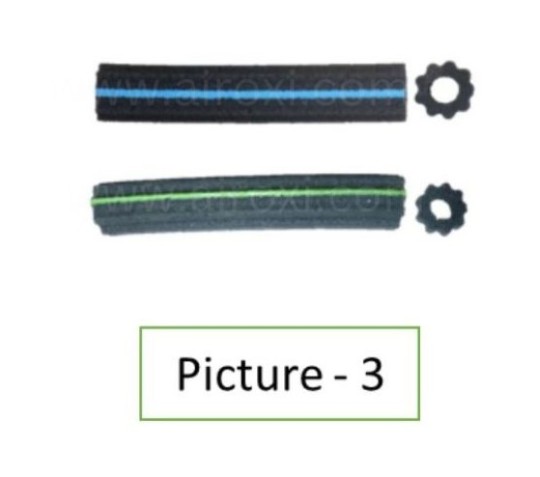
4. AirOxi Pearl - Smooth Tube for RAS (Recirculating Aquaculture Systems): This AirOxi tube is very smooth and has very fine bubbles giving very high DO levels
- Oxygenation Capacity: High
- Water Movement: Medium
- Maintenance Needed: Low
- Blower Suitable: ROOT Blower
- Recommended For: RAS setup

5. Large Diameter Tube with High Airflow (AO250380): This is one of the largest size aeration tube in the world and has a very high flow rate. Also available in algae resistant formulation
- Oxygenation Capacity: High
- Water Movement: Medium
- Maintenance Needed: Low
- Blower Suitable: ROOT Blower
- Recommended For: Biofloc ponds and tanks

6. AirOxi XTRA – This AirOxi tube is made of a different membrane material for low maintenance and low maintenance. It has large bubbles specially for biofloc tanks. This tube has a rough finish
- Oxygenation Capacity: Medium
- Water Movement: Medium
- Maintenance Needed: Low
- Blower Suitable: ROOT Blower
- Recommended For: Biofloc tanks
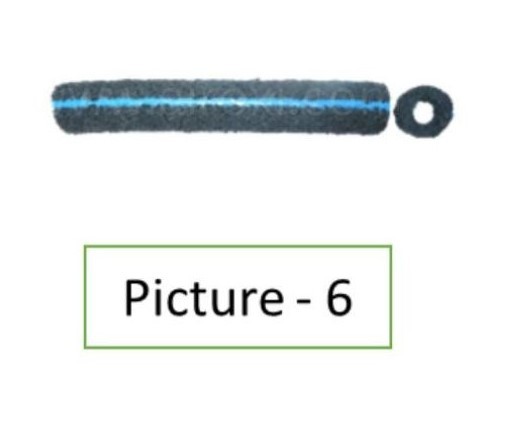
7. AirOxi 19 – This AirOxi tube is a special aeration tube made for nurseries. It has low wall thickness, needs low pressure to operate and gives high water movement needed in nurseries. It is suitable for 1-2 seasons.
- Oxygenation Capacity: Medium
- Water Movement: High
- Maintenance Needed: Low
- Blower Suitable: ROOT Blower + Ring Blower
- Recommended For: Nursery

8. AirOxi 1020 – This AirOxi tube is made for use with air pumps with a smaller inside diameter that fits with air pumps.
- Oxygenation Capacity: Low
- Water Movement: Low
- Maintenance Needed: Low
- Blower Suitable: Air pump
- Recommended For: Small tanks with air pump

9. AirOxi NC-16 – This AirOxi tube is a very thin wall, single season use tube, made of perforated food grade material. It is ideal for mud bottom ponds.
- Oxygenation Capacity: Low
- Water Movement: High
- Maintenance Needed: Low
- Blower Suitable: ROOT + Ring Blower
- Recommended For: Growout pond with mud bottom

These are just a few examples of the diverse range of diffusers available to suit different aquaculture needs. Whether you're managing growout ponds, nurseries, biofloc tanks, or specialized RAS setups. You can contact us for other special diffusers that AirOxi makes.
You can also contact us for technical data sheet and more information on any of these AirOxi tubes.
Applications in Aquaculture Ponds:
AirOxi tubes find versatile applications in various aquaculture setups, including intensive shrimp farming, fish culture, and hatcheries. In shrimp farming, AirOxi tubes are used to maintain optimal oxygen levels in high-density ponds, thereby preventing oxygen depletion and ensuring healthy shrimp growth. Similarly, in fish culture operations, AirOxi tubes play a crucial role in promoting oxygenation and reducing stress among cultured fish species. Moreover, AirOxi tubes are widely utilized in hatcheries for providing oxygen-rich water to developing larvae and fry, thereby enhancing survival rates and growth.
Factors to Consider When Choosing AirOxi Tubes:
When selecting AirOxi tubes for aeration in aquaculture ponds, several factors must be taken into account. Pond size, water depth, stocking density, and the type of blower. Additionally, factors such as oxygen transfer efficiency, durability, ease of installation, and maintenance requirements should also be evaluated. By carefully assessing these factors, aquaculture operators can choose the most suitable AirOxi tubes to meet their specific needs and maximize aeration efficiency in their ponds.
Conclusion:
AirOxi tubes represent a cutting-edge solution for aeration in aquaculture ponds, offering superior oxygen transfer efficiency, durability, and versatility. By understanding the different sizes, types, and applications of AirOxi tubes, aquaculture operators can make informed decisions to optimize oxygen levels and promote the health and productivity of their aquatic organisms. As the aquaculture industry continues to evolve, AirOxi remains at the forefront of innovation, providing sustainable aeration solutions for aquaculture operations worldwide.
Contact us
+917041004098
A simple table is provided here for easy reference


#fish farming#shrimp farming#aeration solution#aquaculture#airoxi tube#airoxitube#aeration tubes#airoxi#aeration#fish
0 notes
Text
ONE AAC PANEL: Your Trusted Source for High-Quality Aerated Concrete Solutions

Looking for top-notch aerated concrete solutions? Look no further than ONE AAC PANEL. As a leading provider of autoclaved aerated concrete (AAC) products, we offer a wide range of AAC panels that are perfect for constructing durable and energy-efficient walls. Our AAC panels are lightweight, fire-resistant, and provide excellent thermal insulation properties. Whether you need AAC panels for residential or commercial projects, we have the perfect solution for you. With our commitment to quality and customer satisfaction, ONE AAC PANEL is your trusted partner in delivering superior AAC solutions.

1 note
·
View note
Text
Sustainable Bathroom Practices in Dubai
Eco-Friendly Solutions for Your Bathroom Renovation
In Dubai, where luxury and environmental consciousness are increasingly intertwined, creating a sustainable bathroom during your bathroom renovation Dubai or bathroom remodeling project showcases your commitment to a greener future. This guide explores various eco-friendly practices and solutions you can incorporate to transform your Dubai bathroom into a haven of relaxation while minimizing your environmental impact.

Key Considerations for Sustainable Bathroom Practices:
The crucial considerations for sustainable bathroom practices in Dubai include:
Water Conservation: Conserving water is vital for sustainability in Dubai's arid climate.
Energy Efficiency: Opting for energy-saving fixtures and appliances reduces your carbon footprint.
Material Selection: Choosing sustainable materials like recycled content or locally sourced options minimizes environmental impact.
Waste Reduction: Minimizing waste generated during renovation and choosing low-maintenance materials reduces future waste.
Water-Saving Strategies:
Implement these water-saving strategies in your bathroom:
Low-flow showerheads and faucets: Install low-flow fixtures that significantly reduce water usage compared to conventional options.
Dual-flush toilets: Opt for toilets that offer a choice of full or partial flushes for water conservation.
Water-saving aerators: These small attachments fitted to faucets can significantly reduce water flow without compromising functionality.
Leak detection and repair: Address any leaks promptly to prevent water wastage.
Energy-Saving Solutions:
Adopt these energy-saving solutions in your bathroom:
LED lighting: Replace traditional incandescent bulbs with energy-efficient LED lights that offer superior energy savings and longer lifespans.
Motion-sensor lighting: Install motion-sensor lights in areas like the bathroom where occupancy is intermittent, reducing unnecessary energy consumption.
Energy-efficient ventilation fans: Choose ventilation fans that are energy-efficient and have timers or humidity sensors to regulate their operation.
Consider heated towel rails: Heated towel rails powered by solar energy or waste heat from your water heater can reduce reliance on electricity.
Sustainable Material Selection:
Make sustainable choices when selecting materials for your bathroom:
Recycled content: Look for fixtures, countertops, or vanities made from recycled materials like glass or plastic, reducing reliance on virgin resources.
Locally sourced materials: Opt for locally sourced materials to minimize transportation-related emissions and support local businesses.
FSC-certified wood: Choose wood products with Forest Stewardship Council (FSC) certification, ensuring sustainable forest management practices.
Natural stone tiles: While requiring careful selection and sealing, natural stone tiles like granite or slate offer durability and a timeless aesthetic with minimal processing compared to some man-made options.
Waste Reduction Practices:
Implement these waste reduction practices during your bathroom renovation:
Salvaged or refurbished materials: Consider using salvaged or refurbished bathroom fixtures or cabinets to give them a new life and reduce waste.
Minimize demolition waste: During the renovation process, plan to minimize the amount of demolition waste generated by carefully salvaging usable materials and disposing of others responsibly.
Low-maintenance materials: Choose low-maintenance materials like engineered wood or porcelain tiles that require minimal cleaning chemicals and replacements, reducing waste in the long run.
Additional Sustainable Practices:
Consider these additional sustainable practices for your bathroom:
Water recycling: Invest in a greywater recycling system to reuse wastewater from showers and sinks for irrigation or toilet flushing.
Natural cleaning products: Opt for natural and biodegradable cleaning products to minimize the use of harsh chemicals and their impact on water quality.
Shower timers: Encourage shorter showers by installing shower timers to raise awareness of water usage.
Conclusion:
Creating a sustainable bathroom in Dubai is a rewarding endeavor that contributes to a greener tomorrow. By incorporating the strategies mentioned above, you can transform your bathroom into a space that embodies both luxury and environmental responsibility. Remember, even small changes can make a significant impact, and your eco-conscious choices can inspire others to adopt sustainable practices within their own homes.
#kitchen#painting#interiors#decor#renovation#dubai#dubailife#uae#bathroom#kitchen renovation#bathroom remodeling
2 notes
·
View notes
Photo

Mushroom Tamale
Prep: 80 mins Cook: 2 hrs 15 mins Soak: 5 mins Total: 3 hrs 40 mins Yield: 24 tamales
Ingredients
For the Filling
1 pound large oyster mushrooms, or other flavorful mushrooms
1 tablespoon grapeseed oil, or olive oil, or other neutral vegetable oil
1/2 yellow onion, thinly sliced
1/2 teaspoon salt
For the Salsa
1/4 cup grapeseed oil, or olive oil, or other neutral vegetable oil
1 head garlic, cloves separated and peeled, divided
1 1/2 ounces (36 grams) dried guajillo peppers (about 5 peppers) or other dried peppers
1/2 teaspoon coriander seeds
1/2 teaspoon black peppercorns
1/4 teaspoon cumin seeds
4 whole cloves
1 cup hot water
1/4 cup apple cider vinegar
2 teaspoons sea salt or other high-quality salt
1/2 yellow onion, coarsely chopped
For the Masa
3 cups masa harina
1 tablespoon baking powder
1 tablespoon sea salt
1 cup grapeseed oil, or olive oil, or other neutral vegetable oil
3 to 4 cups vegetable stock, or water, divided
50 corn husks
Steps to Make It
Make the Filling
Clean the mushrooms. Tear or cut them into 1-inch-sized pieces.
Heat grapeseed oil in a large saucepan on medium heat. Add sliced onions and salt and cook until the onions are golden brown, about 10 minutes. Add the mushrooms and continue cooking on medium-low heat until softened, about 5 minutes. If not using right away, store cooked mushrooms and onions in an airtight container in the refrigerator.
Make the Sauce
Confit the garlic: In a small saucepan on medium-low heat, heat 1/4 cup grapeseed oil. Add half of the peeled garlic cloves. Cook, stirring occasionally, until the cloves of garlic turn light golden brown, about 15 minutes. Remove from heat immediately and allow garlic to cool.
Stem and deseed the guajillo chiles. Hold the end of a chile with one hand, use a very sharp knife, and cut off the stem and calyx (the part that connects the stem to the chile). Pour out any remaining seeds. Set aside.
In another pan on medium-high heat, toast the dried peppers on each side until the skin darkens and their fragrance is released, about 1 1/2 minutes. Do this in batches if necessary to avoid crowding the pan.
Remove and add the chiles to a blender. Set aside.
Toast the coriander, black peppercorns, cumin seeds, and cloves in the same pan over medium heat until they release their fragrance, about 30 to 45 seconds. Remove spices from heat immediately and set aside in a small bowl to cool.
Add hot water, vinegar, and salt to the toasted chiles in the blender. This is an acidic saline solution that will soften the peppers. Cover with the lid and allow to steep until the chiles are soft, about 2 to 3 minutes.
Once the peppers are soft, add the toasted spices, the remaining garlic cloves, and the chopped onion, and blend until smooth. Slowly drizzle in the garlic confit (the garlic and the oil it cooked in) and continue to blend to create a smooth, emulsified base.
Pour half of the sauce and the mushrooms into a saucepan and cook over medium-low heat for about 5 to 6 minutes. Remove the pan from the heat and allow the filling to cool before using. If not using right away, store filling in an airtight container in the refrigerator.
Add the other half of the sauce to a saucepan and simmer over low heat for an additional 10 to 30 minutes, stirring occasionally, so it does not stick to the bottom. The longer the sauce cooks, the more fully developed the flavors will be. If not using right away, store sauce in an airtight container in the refrigerator.
Make the Dough
In a large bowl, mix together the masa harina, baking powder, and salt. Slowly drizzle the grapeseed oil into the flour, mixing with an electric mixer as you pour.
Do the same with the vegetable stock, whipping at a higher speed. Continue whipping until the dough is light and fluffy, about 3 to 5 minutes. If it looks dry, add more vegetable stock. Whipping aerates the dough for a fluffy texture. Your consistency should feel smooth, thick, and creamy, like ricotta. Taste for seasoning. Store in an airtight container and refrigerate until ready for use.
Assemble and Cook the Tamales
Remove corn husks from the package and submerge all into a deep bowl of hot water. Soak until soft and pliable, about 5 minutes.
Working with 2 to 4 husks at a time, or 1 at a time, if you are a beginner, shake off excess water before laying the husk out onto a clean work surface area.
Take 2 or 3 of the husks, and tear them lengthwise, following the grain, into quarter-inch-thick strips. You will use these to tie the tamales together; or you can use kitchen twine. Set aside on a small plate.
Set out all of the components of the tamales in an assembly line: Husks, masa, filling, and shredded husks.
Spoon about 2 tablespoons of dough onto the center of each husk, about 1/2 inch away from the widest end. Top with a heaping tablespoons of filling in the center of the dough. If your husks are very narrow, use two overlapping husks.
Now you are ready to fold the tamales. Carefully bring the sides together to meet at the center, enclosing the filling.
Then, fold the narrow tip of the husk over the filled section. Take one of the husk strips and use it to tie the tamale together, crosswise. Set aside.
Set a steamer basket inside a large pot and pour water just until it reaches the basket. Bring the water to a simmer. Begin layering in the tamales, folded-end down. Cover with a lid and cook over medium heat. Steam for 45 minutes.
Once tamales are cooked, remove them from the pot and cool until they can be handled. Eat immediately, drizzled with the reserved salsa.
Warnings
After steaming the tamales, open lid slowly and carefully. The steam released can be hot enough to burn skin.
Take care to wash your hands thoroughly after handling chiles. Some people use gloves or wrap their hands in plastic bags to protect themselves. Oils from the chiles can irritate your eyes and nose if you handle chiles and then absentmindedly touch your face.
Be on guard when toasting the spices and peppers. It is a quick process and your ingredients may easily burn if you are not mindful.
Tips
Save the stems of your mushrooms to make an umami-rich vegetable stock in the future.
Take time to invest in high-quality ingredients for the best-tasting, and most nutrient-rich results.
We recommend Bob’s Red Mill masa harina, available at most grocery stores
Chiles, masa harina, and corn husks may be found in the International section of your grocery store, or at a Latin American market, or via Masienda.com.
We recommend buying spices from Diaspora Co. for the freshest flavors.
Recipe Variation
If mushrooms are not your thing, substitute beans, canned jackfruit, spaghetti squash, or butternut squash.
Make the tamales with banana leaves instead of corn husks. Trim the leaves to 8-inch squares. Use the same method to fold and then tie shut with kitchen string.
How to Store and Freeze
Store cooked and cooled tamales in an airtight container, or in a zip lock or vacuum-sealed bag in the refrigerator.
Keep tamales in the refrigerator for up to one week.
To reheat, steam in husks for 5 to 8 minutes; or reheat in the microwave for 3 to 5 minutes.
To freeze tamales, wrap individually in foil, then place in a freezer bag. They will keep for about a month.
Thaw frozen tamales overnight in the fridge and re-steam for 5 to 8 minutes. Or, skip thawing and re-steam for 15 minutes.
Make Ahead
The filling and sauce can be up to a month in advance if frozen. Simply defrost and reheat in microwave, then cool the filling enough to use.
The dough can be made a day in advance if you are using masa harina; in fact, the dough will be better hydrated if it sits for a day.
If you make the dough from fresh masa (rather than from masa harina) you will need to use it right away. Otherwise, the dough will begin to ferment.
Husks can be soaked in room-temperature water overnight instead of in hot water.
22 notes
·
View notes
Text
HDPE Grow Bag
The HDPE Grow Bag is a long-lasting and adaptable gardening solution made of high-density polyethylene. Long-lasting use is ensured by its strong structure, and appropriate root aeration is promoted by the breathable material. Perfect for growing a range of plants in a practical and space-saving way.
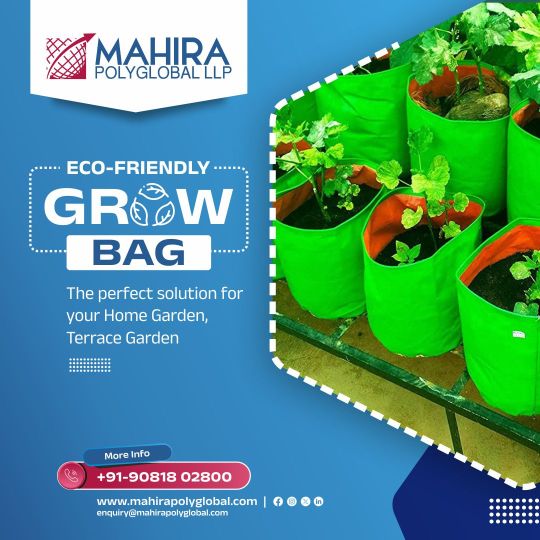
For more information, contact us - +91- 9081802800 and can send e-mail : [email protected]
#artwork#branding#ecommerce#marketing#sales#hdpeplanterbag#hdpegrowbag#hdpeppbag#ppbag#gardeningbag#plantbag#growbagmanufacturer#growbagsupplier
1 note
·
View note